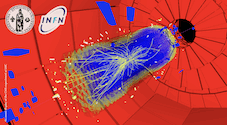Speaker
Dr
Valeria Sipala
(INFN Catania and Dip. Fisica Univ Catania, Italy)
Description
Proton Computed Tomography (pCT) is a medical imaging method based on the use of proton beams with kinetic energy of the order of 250 MeV, aimed at directly measuring the stopping power distribution of tissues (presently calculated from X-rays attenuation coefficients) to improve the accuracy of treatment planning in hadron therapy. A pCT system should be able to measure tissue electron density with an accuracy better than 1% and with a spatial resolution better than 1 mm. The blurring effect due to multiple Coulomb scattering can be circumvented by single proton tracking. In the framework of the PRIMA project (INFN-CSN5) we manufactured a first proprietary apparatus to undergo proton computed tomography (pCT). The system, able to carry out single projections at different rotating angles of the phantom, is characterized by a field of view of about 5x5cm2 and an acquisition time of the order of 10s (10 kHz, 105 events). It includes a tracker, made of silicon microstrip detectors, to measure proton trajectory, and a calorimeter, made of four YAG:Ce optically separated crystals, to measure the residual energy. The complete system has been characterized with 62MeV protons at Laboratori Nazionali del Sud (LNS-INFN) and first tomographic images have been reconstructed with this prototype: main results will be showed and discussed. The design and manufacture of a novel prototype of pCT system for pre-clinical applications is now under process. The system is characterized by: (a) A larger active area and (b) An acquisition system able to store data from a whole tomographic image without dead times. The larger active area will be obtained by considering a slice of four silicon microstrip detectors on each x-y plane of the tracker, to cover a 5x20cm2 rectangular area and a larger calorimeter volume. When completed, the system will be able to undergo pre-clinical validations with hadron-therapy machines.
Author
Prof.
Mara Bruzzi
(INFN Firenze and Dip Energetica Univ. Firenze)
Co-authors
Dr
Carlo Civinini
(INFN Firenze, Via G. Sansone 1, Sesto Fiorentino, Firenze, Italy)
Dr
Cinzia Talamonti
(INFN Firenze and Dip. Fisiopatologia Clinica Univ. Firenze)
Dr
Concetta Stancampiano
(INFN Catania and Dip. Fisica Univ Catania, Italy)
Dr
Domenico Lo Presti
(INFN Catania and Dip. Fisica Università di Catania, Italy)
Dr
G.A.Pablo Cirrone
(INFN Laboratori Nazionali del Sud, Catania, Italy)
Dr
Giacomo Cuttone
(INFN Laboratori Nazionali del Sud, Catania, Italy)
Prof.
Marta Bucciolini
(INFN Firenze and Dip. Fisiopatologia Clinica Univ. Firenze)
Mr
Mauro Tesi
(INFN Firenze and Dip Energetica Univ. Firenze)
Mr
Mirko Brianzi
(INFN Firenze, Via G. Sansone 1, Sesto Fiorentino, Firenze, Italy)
Dr
Monica Scaringella
(INFN Firenze and Dip. Energetica Univ Firenze)
Dr
Nunzio Randazzo
(INFN Catania and Dip. Fisica Università di Catania, Italy)
Dr
Riccardo Mori
(INFN Firenze and Dip. Energetica Univ. Firenze)
Dr
Stefania Pallotta
(INFN Firenze and Dip. Fisiopatologia Clinica, Univ Firenze)
Dr
Valeria Sipala
(INFN Catania and Dip. Fisica Univ Catania, Italy)

